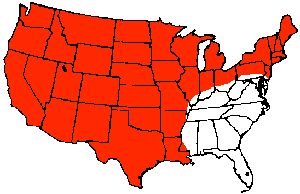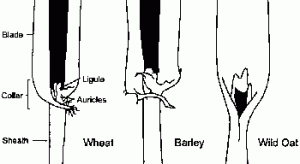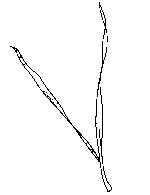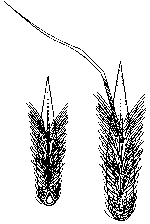Wild Oat Control in Texas
Billy E. Warrick and Todd Baughman, Extension Agronomists
Wild oat, Avena fatua, is a severe problem in the Rolling Plains and the northern Blacklands of Texas Infestations range from scattered stands along ditches and edges of fields to severe infestations that prevent wheat harvest.
Wild oat causes yield reductions directly by competing with the crop for moisture, light, and nutrients. Such losses occur early in the growing season. Most of the yield loss occurs before the crop is 45 to 50 days old. In addition to yield losses, wild oat may cause dockage at the elevator, increased tillage, reduced yields from delayed seeding, and increased expenditures for herbicides. Compared to herbicides used to control broadleaf weeds in small grains, effective wild oat control herbicides are expensive.
Wild oat infests 28 million acres of land in the United States. North Dakota is the most seriously infested state, with annual losses ranging from $150 to $200 million annually. Wild oat is extremely competitive and difficult to control because:
- It has delayed germination.
- It shatters its seed before most crops are harvested.
- Its growth habit is similar to that of wheat, barley, and domesticated oats.
Identification
Early identification and treatment of wild oat plants is essential for control measures to be successful, but identifying wild oat seedlings in small grains is often difficult. Accurate identification is based on several distinctive characteristics of the wild oat plant.
Wild oat has an elongating first internode and coleoptile. Because of this characteristic, wild oat seedlings can emerge from greater depths in the soil than wheat and barley, which have only an elongating coleoptile. Research indicates that, under certain conditions, wild oat is capable of emerging from depths as great as 9 inches.
Another characteristic useful for early identification is the absence of auricles in wild oat. The leaves of wheat and barley have auricles that grow outward from opposite ends of the leaf collar, but these are completely lacking in wild oat (Figure 2).
A third distinctive characteristic is the twist of the leaf blade. The leaf blade of all grass plants has a characteristic twist. The leaf twist of wild oat is counterclockwise (Figure 3), while wheat and barley leaves roll clockwise. In addition, the inflorescence (arrangement of flowers) of a mature wild oat plant is a spreading open panicle that often droops.
Wild oat seed vary in color from yellowish white to different shades of grey, brown, or black. A prominent depression or scar, sometimes called a “sucker mouth,” is found at the base of the seed (Figure 4). The seed have prominent hairs at their base, and a twisted and bent awn (a hair-like appendage, also called a “beard”) rises from the middle of the back of each seed. Domesticated oat seed usually are lighter in color and do not have the hair.
Life Cycle And Growth Habit
Wild oat is an annual that reproduces from seed. It germinates best when soil temperatures are cool, so very little wild oat seed germinates during the warm summer months. The weed shatters its seed early, before most crops are harvested. Freshly shattered wild oat seeds are generally dormant and therefore protected from fall germination and subsequent winter kill. However, dormancy periods in freshly shattered seed vary with the growing conditions during development. Wild oat seeds also have secondary dormancy that keeps the seed from germinating under unfavorable conditions such as high summer temperatures.
Wild oat plants rarely produce more than 200 seed, but viable seed are produced rapidly, generally within 7 to 10 days after heading. The twisted, bent awn that rises from the back of each seed is straightened and rewound repeatedly by moist conditions and often serves as a mechanism for covering freshly shattered seed.
The Problem
Wild oat is very competitive. Researchers from several states have presented information about the wild oat problem, indicating that heavy infestations could reduce wheat yield by one-third. Results from tests in Texas from 1991 to 1994 indicate wheat yield reduction as high as 80 percent. One wild oat head per square foot reduced wheat yield 6 percent, and the average wild oat plant can produce 3 to 6 heads. In badly infested fields, wild oat heads exceeded 25 per square foot and resulted in severe yield reductions.
Wild oat seed may lie dormant for up to 6 years if left near the soil surface. If worked deeply into the soil, seed may remain dormant for many years. Deep plowing does not rid an area of wild oat; it only prolongs the problem.
Wild oat is being spread in Texas in these ways:
- Planting seed contaminated with wild oat seeds. The Texas seed law allows up to 300 wild oat seed per pound of commercial seed, so simply purchasing seed does not ensure that it is wildoat-free.
- Moving combines and other equipment from infested fields to clean fields. Many fields have a strip of wild oat around the edge and none in the center. As the combine moves across the field, wild oat seed is carried with it. In addition, seeds of wild oat are carried easily from field to field by other farm equipment.
- Wind and water moving across fields.
- Birds and fur-bearing animals transporting seeds as they move.
Prevention
Preventing wild oat from starting in clean fields is the most economical control method. Prevent the spread of seeds by following these precautions:
- Buy seed that is free from wild oat contamination. Purchasing small grain seed with wild oat could be one of the most expensive purchases you ever make. Even with diligent effort, it takes several years to clean fields of wild oat infestation.
- Do not use contaminated machinery in a clean field.
- Clean harvest equipment before entering the field. Combine clean fields first, and then clean the combine after harvesting the infested fields. Combine fields that have small areas of wild oat last and carefully empty and clean all equipment involved in harvest.
- Clean field-run seed and use a gravity table. These measures can significantly reduce wild oat seed in farmer-caught seed lots.
Cultural Control
Cultural practices can reduce wild oat stands at minimal cost. Follow these steps:
- Rogue the field if small infestations exist. When the wild oat develops so that it can be distinguished from the desired small grains, pull the wild oat plants from the field and destroy them. Do not let heads shatter and reseed the fields. To keep infestations from spreading and plants from maturing, mow stands in ditches and fence rows around the field or spray with MSMA or glyphosate (Roundup® and others) before seed production.
- Rotate crops when wild oat becomes severe. Wild oat germinates in cool soil during the fall or early spring. It is a winter annual, and, like winter wheat, it requires cold weather to produce seed. Wild oat emerging in the summer do not produce seed. They are easily controlled with several of the herbicides used in summer row crops. Timely cultivation to keep wild oat from producing seed is important. If plants that emerge are kept from producing seed for 3 or 4 years, viable seed numbers in the soil will be reduced to manageable levels. Rogueing a wheat crop eliminates the few remaining wild oat plants.
- Graze-out heavily infested small grain fields. Heavy grazing pressure or plowing before wild oat produce viable seed helps to prevent reseeding.
- If wild oat is in the field, seed late in the fall. This reduces grazing, but it will probably pay dividends in the long run. When moisture is available to germinate wild oat early in the fall, plow or use herbicides to control it before planting the crop. This removes the initial infestation in wheat, and plants that come up late are less competitive.
- Produce a strong competitive crop. A heavy seeding rate makes a crop more competitive and may help in areas where wild oat is a problem. Wild oat is most competitive with wheat that is grown under a low fertility regime. Adequate levels of nitrogen and phosphorus in the soil increase the competitiveness of wheat relative to wild oat.
Chemical Control
Research and demonstrations with herbicides have shown that wild oat can be controlled. A recommended procedure is late fall seeding in fields with wild oat infestations. Then apply glyphosate (Roundup® and others) to kill emerged wild oat before planting the crop. If this method is used, it is important to minimize soil movement at the time of planting.
Fourteen herbicides are registered for wild oat control in wheat. These are:
Assert® and Avenge® from BASF,
Cheyenne®, Everest®, Hoelon®, Olympus®, OspreyTM, Puma®, Silverado®, and Tiller® from Bayer,
Far-go®8, Maverick® or Maverick Pro® from Monsanto,
Achieve® from Syngenta
Eight herbicides are registered for wild oat control in barley. These are:
Buckle®, Assert® and Avenge® from BASF,
Hoelon®, Puma®, and Tiller® from Bayer,
Far-go® from Monsanto,
Achieve® from Syngenta
No herbicide gives 100-percent control, but, if they are used in conjunction with good cultural practices, adequate control can be obtained and herbicide applications can be justified economically. Grazing and haying restrictions vary between herbicides and producers should refer to the label for complete information.
Far-go® is a preplant-incorporated herbicide which comes in liquid and granular forms. It may be applied immediately after planting but before emergence. Incorporate the herbicide no deeper than 1 inch. Planted wheat must be at least 1/2 inch below the treated layer or injury will occur. The soil should be loose and mellow. Clods or trash cause poor incorporation and poor wild oat control. Best results are obtained when incorporation is done twice in opposite directions. Incorporate the herbicide immediately after application with a spring tooth harrow (field cultivator), or a rolling cultivator set for shallow incorporation, in a well prepared seedbed. Incorporation with a tandem disk or offset disk plow is too deep and causes severe injury to wheat.
The remaining herbicides listed above are applied post-emergence over the top of the growing wheat or barley crop. Time the applications so that the wild oat plants are in the two- to five-leaf stage. Best control is achieved on smaller plants, but consideration must be given to the non-uniform emergence of wild oat. If the applications are made too early, many of the weeds may not have emerged. If the applications are made too late, control is reduced, and you must use higher rates of the herbicide to achieve effective control. Assert offers some control of broadleaf weeds such as mustards and may have residual soil activity, while Avenge and Tiller have no residual activity.
Before using any herbicide, always read the label and follow all the directions listed. Rates, amounts, and the nozzle angle necessary for effective control are described on labels.
Disclaimer
The information given herein is for educational purposes only. Reference to commercial products or trade names is made with the understanding that no discrimination is intended and no endorsement by the AgriLife Extension Service is implied.
Educational programs of Texas AgriLife Extension Service are open to all people without regard to race, color, sex, disability, religion, age or national origin.
Issued in furtherance of AgriLife Extension Service Work in Agriculture and Home Economics, Acts of Congress of May 8, 1914, as amended, and June 30, 1914, in cooperation with the United States Department of Agriculture. Edward Smith, Director, Texas AgriLife Extension Service, The Texas A&M University System.




